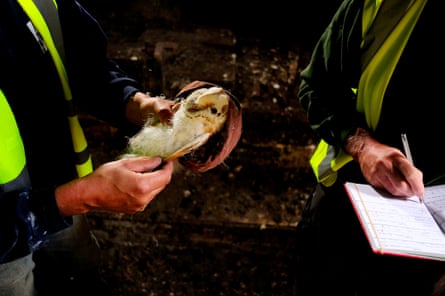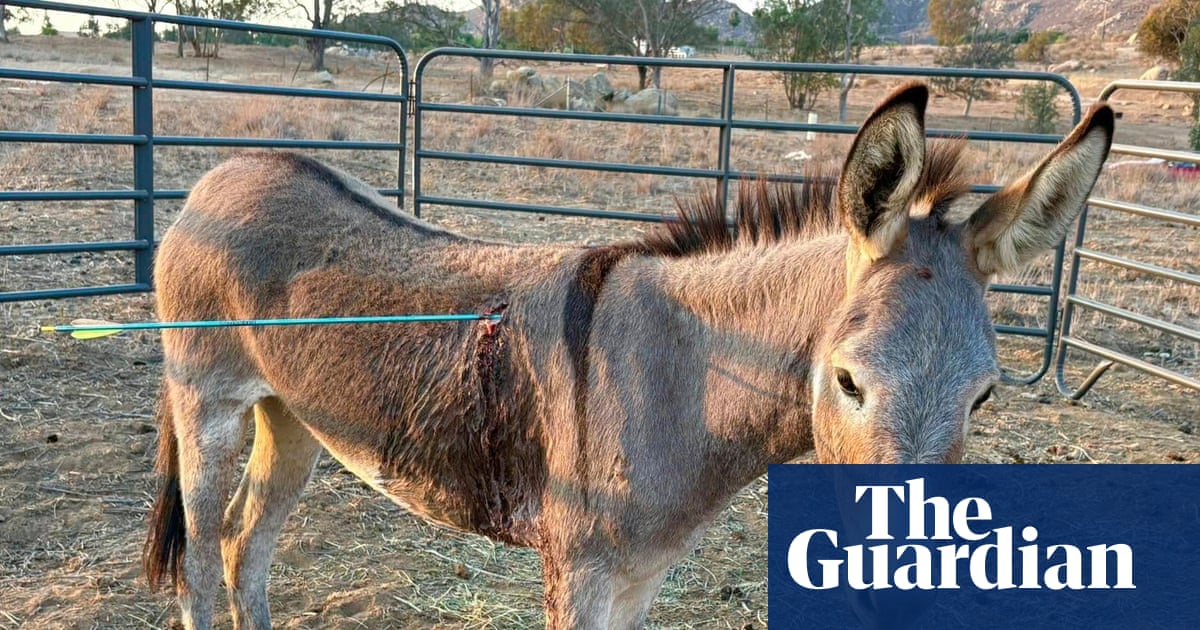It is dusk, a short walk from the big Ikea in Croydon, and a barn owl is emerging from its nest to hunt. In the fading light, the male owl sits on a fence post to survey the rough grass below. He has a busy evening ahead: he is responsible for feeding a roosting female for the next few weeks while she cares for their chicks. The owl hops to another fence post. Suddenly, he dives into the grass below, emerging a minute later with an unlucky rodent, and flies back into the nest.
“I still get really excited,” says Tomos Brangwyn, a local enthusiast who monitors the site, lowering his binoculars. “He’ll do that most of the night. It’s a great sign that there’s a female in there that we haven’t seen for a while, as she’s on the eggs,” he says.
The scrubland is surrounded by urban sprawl. Police sirens and souped-up cars roar past, and industrial buildings hum under harsh security lights nearby. Central London is less than 10 miles (16km) away, but the barn owls here are unperturbed, feasting on the same diet of voles, rats, mice and other small animals as their country cousins. This patch of land has supported as many as three breeding pairs in recent years.
Owl sightings have risen sharply in the capital, monitoring data shows, with Londoners increasingly seeing the birds in green areas and back gardens. There were just 25 barn owl sightings in 2010, but 347 spotted a decade later.

“People might not think owls are in London. But they don’t realise how wild the city actually is,” says Becky Garden, a partnership officer for Greenspace Information for Greater London CIC (GiGL), which records environmental data for the capital.
All of the UK’s owl species – the tawny, barn, short-eared, long-eared and little – can be found in the capital at various points of the year. The shy, nocturnal hunters can be hard to monitor, with almost no reliable population surveys performed for many years. Sighting data is considered a measure of presence, rather than of population size, as it may also be driven by the rise of popular citizen science apps and awareness campaigns such as the Owl Prowl run by London Wildlife Trust. But most Londoners are probably not far away from an owl, even if they never see them, says Garden. “Records of owls in London have increased quite a lot from about 2016,” she says.
Tawny owls – known for the “twit twoo” duet sung by males and females to each other – are found in green areas throughout the capital, nesting in hollow tree species and even known to prey on green parakeets. Reports of sightings have increased from 159 in 2010 to 894 in 2020.
Short- and long-eared owls are infrequent winter visitors. Little owls are found in larger parks, similar to barn owls. But barn owls have also been spotted in Notting Hill, Deptford and other places that were probably one-off visits. The birds sometimes surprise Londoners: last month, journalist Ash Sarkar posted a photo of one in north London on social media under the tagline “Wtf is a barn owl doing in Tottenham???”.

The apparent resurgence of the barn owl reflects broader national trends, with the species experiencing a significant recovery in recent years. The last thorough survey in the mid-90s estimated the population to be about 4,000 breeding pairs in the UK, but the British Trust for Ornithology (BTO) believes it may now exceed 10,000. It is no longer listed as a threatened species in the UK, benefiting from a rollout of barn owl boxes and sufficient habitat to hunt rodents. But the overall owl population is not as healthy.
“With the exception of the barn owl, they are all not doing brilliantly. There’s a bit of a decline across the board. It is most pronounced in the little owl, that seems to be having a really tough time of it, linked to insect decline,” says Jon Carter from the BTO. “But barn owls have turned a bit of a corner. They are doing really, really well.”
The owls are reasonably common in large gardens, town parks and city areas, Carter says. “Wherever you live, if you’ve got bit of leafy stuff around, odds are there are going to be owls nearby,” he says. “Because they sleep all day long and are as quiet as anything at night when they’re flying around hunting, people just don’t really notice them unless they’re right outside the window hooting away.”
Find more age of extinction coverage here, and follow the biodiversity reporters Phoebe Weston and Patrick Greenfield in the Guardian app for more nature coverage

.png) 3 months ago
46
3 months ago
46

















































